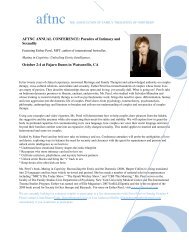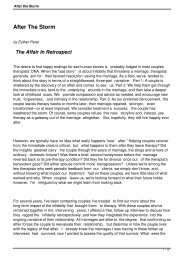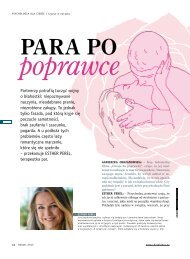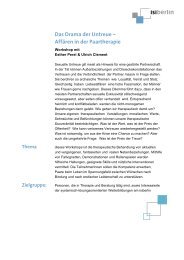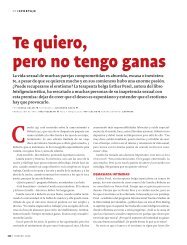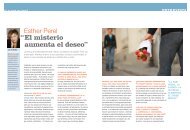The-Double-Flame 2.pdf - Esther Perel
The-Double-Flame 2.pdf - Esther Perel
The-Double-Flame 2.pdf - Esther Perel
Create successful ePaper yourself
Turn your PDF publications into a flip-book with our unique Google optimized e-Paper software.
<strong>The</strong> <strong>Double</strong> <strong>Flame</strong> 27<br />
Let me illustrate: Think of a little child who sits comfortably nestled<br />
on your lap. At some point she jumps off and runs out. At a distance,<br />
she stops, turns, and get her cues from the adult she just left. If<br />
the adult says, “Go ahead, kiddo, the world is a beautiful place with<br />
lots to discover. Have fun,” the little child turns away and runs further.<br />
She experiences both freedom and connection, and at the same<br />
time, the security of love and the autonomy of desire. This child who<br />
plays hide and seek will one day turn to eroticism as the adult version<br />
of hide and seek, where she’ll maintain playfulness and discovery,<br />
alternating between the dangers of hiding and seeking and the relief<br />
of finding and being found.<br />
<strong>The</strong>re is, however, another scenario with a very different outcome.<br />
This time the adult says: “What’s so beautiful out there? Isn’t being<br />
together enough? I am lonely, I am anxious, depressed . . . ” Here,<br />
the child has a few choices. One of them is to return to base. <strong>The</strong>y<br />
learn that in order not to lose that connection with the other, they’ll<br />
have to lose a part of themselves. In my experience these are often the<br />
people who, later on, will have a hard time making love to the person<br />
they love. <strong>The</strong> legacy of this bargain for attachment produces a puzzling<br />
inverse correlation where growing intimacy leads to diminished<br />
desire. In his book Arousal: <strong>The</strong> Secret Logic of Sexual Fantasies,<br />
Michael Bader (2002) explains that it isn’t a fear of intimacy or a<br />
lack of commitment that solders their block, rather it is the nature of<br />
their love—burdensome and confining—that stands in the way of the<br />
desire. <strong>The</strong> worry and responsibility they feel for their beloved forecloses<br />
the necessary spontaneity and selfishness for erotic abandon.<br />
Sexual intimacy is an act of generosity and self-centeredness, of<br />
giving and taking. We need to be able to enter another without the<br />
terror that we will be swallowed and lose ourselves. At the same time<br />
we need to be able to enter ourselves, to surrender to self-absorption<br />
while in the presence of the other, believing that they will still be<br />
there when we return, that they won’t feel rejected by our momentary<br />
Copyright © 2010 <strong>The</strong> Guilford Press<br />
absence. <strong>The</strong> self absorption inherent in sexual excitement obliterates<br />
the other in a way that collides with the ideal of intimacy. So many<br />
people believe that they can be safely lustful and intemperate only<br />
with people they don’t know as well, or care about as much.<br />
Tell me how you were loved, I’ll tell you how you make love. This<br />
is a construct I often work with. Our sexual preferences arise from the<br />
thrills, challenges, and conflicts of our early life. How these bear on<br />
our threshold for closeness and pleasure is the object of our excavation.<br />
Not coincidentally, our entire emotional history plays itself out





